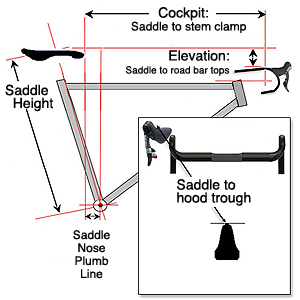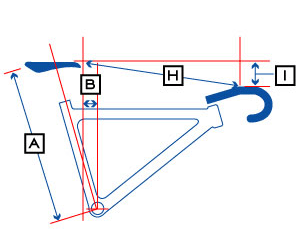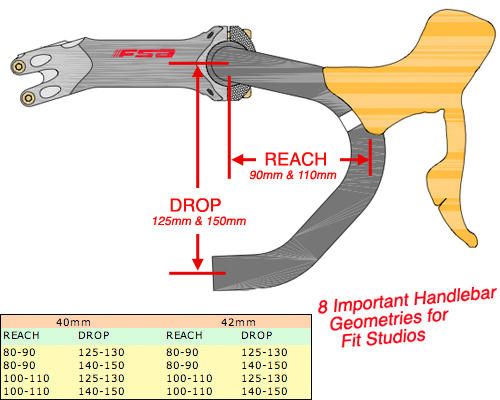Coordinate Predictors Versus Body Angles in Road Bike Fit

I'm forced to repent of a long held tradition of mine in bike fit. I'm abandoning, in some cases, the use of body angles as a determiner of position appropriateness. This is going to cause some hand wringing, I know, but let me explain.
First off, this does not affect tri bike fit. Only road bike fit. And only angles other than the knee angle. This does not mean I'm leaving cockpit distance and handlebar elevation without anything other than the fitter's good eye as the arbiter. Static formulae take the place of body angles, and not as drivers of position, rather, as confirmation of appropriateness.
Fixed versus fungible
Tri bikes feature one over-arching, predominant, urgent, position. It's not that the out-of-the-aero position is unimportant. But, if everything is A-ok, you should be out of the aero position almost never, as a percentage of your overall bike split, during the bike leg of a triathlon. Therefore, we fit to one position.
Further, there's very little fore/aft movement during the bike ride when you're in that position. A centimeter or two here or there. Not much. Notwithstanding their great accomplishments aboard their TT bikes, when you see Alberto Contador and George Hincapie moving fore and aft, fore and aft, on their TT bikes, that's not optimal. That's indicative of a mismatch between seat angle and cockpit distance.
Road bikes, well, throw all that out the window. There is not one predominant hand position on the front of the bike, but three: hoods, drops and tops. There is no single place you sit on the road saddle, rather, the grade, the effort you're putting forth, and your chosen hand position, changes where you sit on your road bike saddle.
The road position is highly fungible, and the hip, elbow and shoulder angles your body forms when riding correspondingly fungible. And therefore not reliably measurable.
Now, if your fitter forces you to strike a particular posture aboard a bike—the so-called "neutral" position, which is seated, hands on hoods—body angles can be forced on you. But even in the neutral position, it is my experience that the hip angle is more obtuse during easy riding, more acute during hard riding, and somewhere in between when the effort is somewhere in between.
The position aboard a tri bike is relatively fixed, irrespective of effort and even grade.
Elbows
The difficulty in using body angles for road bike riding is caused by the freedom given you by the road bike. The variety of hand positions offered accentuates the movement fore/aft on the saddle. Seated, hands-on-tops is a typical rhythm climbing position. But it's also typified by a move aft on the saddle. Seated, hands-on-drops, generates the opposite result: a move forward on the saddle. Hence the term riding "the rivet."
This is accentuated by a rider's ability to bend his elbows and so change his hip and shoulder angles. Not possible in tri. But evident in road.
Think of it this way: If you're anchored, with nowhere to go, then a goniometer or a motion capture system that measures body angles has merit. Not as a driver of position, but as a confirmation of position. When are two contact points spatially fixed, yielding a reliable result given to an angular measure? Seat height is one example. Unless you're on a beam bike, your saddle can't expand or contract its distance from the bottom bracket. So, seat height, tri or road, yields knee angles easily measurable.
Likewise, when your arms are in the aero bars, you can't contract or expand the elevation of your elbows versus another fixed point on the bike, such as the top of the saddle. Ergo, this yields body angles easily measurable.
Static double-checks
Saddle set-backs are reliably 9.0 percent of saddle heights, as a mean, among Pro Tour riders in Mediterranean countries. This, based on several dozen positions in my data archives. Handlebar elevations are reliably 11.0 percent of saddle heights, as a mean (Y axis, saddle height to the top of the handlebars, just aside the stem).
A couple of weeks ago I asked Slowtwitchers who've been racing bikes at a high level, for a long time, to give me their road bike fit coordinates. The mean saddle set back of several dozen of you who chose to give me your coordinates was 8.25% of saddle height. The mean handlebar elevation was 11.25%. So, you all were, on average, slightly less set back and correspondingly—and predictably—riding with a slight bit more handlebar elevation drop.
Why the difference between pro road racers in these Mediterranean countries and the typical bike racing Slowtwitcher? My guess—and it is only a guess—is that some among you do not live in hilly areas, do not ride hills, and have your bikes set up to favor flatter riding. Compare that to every Spanish, Italian or Southern French pro road cyclist climbs a lot on his bike. But, I don't know if this explains the delta between Slowtwitchers and Pro Tour riders. It's just a guess.
I also note while talking to many of you that your drops are virtually unusable. Personally, I find that unfortunate, and probably indicative of either: 1) An overall handlebar drop that is too severe; or 2) Proper hoods and tops elevations, but a bar geometry that is not optimized for you (you need a handlebar with a shallower drop).
Finally, here's an equation that takes morphology—long or short legs or torso—into account, and predicts the length of the bike position:
Saddle nose => Hood trough = (.72)(Overall height) – (.78)(Saddle height)
So, for me, it would be 75.5cm of saddle height (BB to top of saddle, midway between fore and aft), multiplied by .78 = 58.9cm. This amount is subtracted from my overall height of 185cm x .72 = 133.2cm. The result is 74.3c, and in fact I ride with 74.5cm.
But, be careful. In my population of pros you'll find +/-3.5cm in the extreme, and a standard deviation of 2.7. So, if you were to use this formula, you'd have to attach a range of something like +/- 2.5cm, and even then allow for outliers who exceed that range. And 5cm in the aggregate is a pretty big range.
Same thing with percentages of saddle height as set back and handlebar elevation predictors. They're predictors, not drivers. However, when I compare this to the range required when using body angles; times the lack of precision inherent in these highly fungible body angles that attend road bike riding; times practitioner error in landmark identification; it's my experience and conclusion that static measures—as double checks, rather than as coordinate drivers—make more sense. Again: for road, not for tri.
The further elegance of this approach is its continual drawing back toward the orthodox. As we see, there's nothing difficult in adopting the position of a Pro Tour rider. This is simply the way road race bikes are best ridden across the range of pitches and grades and terrain and topography for which they're designed.
I have accordingly altered my own road bike fit protocol to reflect this new way I choose to confirm the validity and utility of the road bike fit coordinates generated during a bike fit session.




Start the discussion at slowtwitch.northend.network